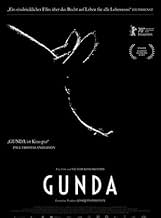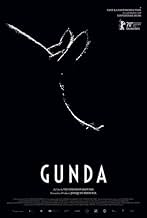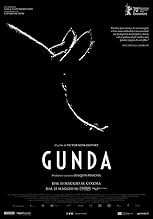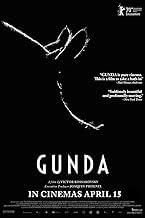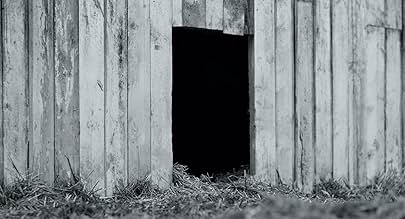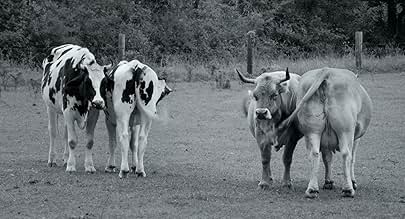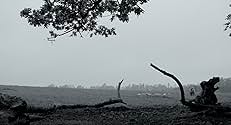AVALIAÇÃO DA IMDb
7,1/10
3,1 mil
SUA AVALIAÇÃO
Relata a vida diária de um porco e seus companheiros de fazenda: duas vacas e uma galinha de uma perna.Relata a vida diária de um porco e seus companheiros de fazenda: duas vacas e uma galinha de uma perna.Relata a vida diária de um porco e seus companheiros de fazenda: duas vacas e uma galinha de uma perna.
- Direção
- Roteiristas
- Artista
- Prêmios
- 9 vitórias e 32 indicações no total
- Direção
- Roteiristas
- Elenco e equipe completos
- Produção, bilheteria e muito mais no IMDbPro
Avaliações em destaque
Looks like this film sometimes can't decide what it wants itself to be. Overall, it uses a highly poetic language with desaturated picture and "commercial" outlook with long dolly shots, wide angles and slow motion. At the same time, it always tends to be on animals' eyes level, depicting some of the unpleasant and cruel aspects of their life. However, it seems that camera is sometimes shy about what it sees, notably putting pig's back out of focus in final scene - which inevitably drives us to a conclusion that it's the human look on the animal, even if there's not a single human in frame. Surprisingly, the most coherent and touching part of three isolated novels is the one about chicken - particularly because of non-intrusive and highly tactile camera work.
Gunda stays somewhere between brutal realism of life and romantic pamphlet against cruelty to animals, mixing together two incompatible aesthetic approaches. However, a film like this had to be made, and I hope it will influence other filmmakers to experiment with storytelling from an animal point of view.
Gunda stays somewhere between brutal realism of life and romantic pamphlet against cruelty to animals, mixing together two incompatible aesthetic approaches. However, a film like this had to be made, and I hope it will influence other filmmakers to experiment with storytelling from an animal point of view.
At first, we can't grasp what we are seeing, and it takes a while to sink in. Throughout the film, both beauty and reality will often rise up to temporarily disorient, take our breath away, and even overwhelm.
This is not your cute animal film, though it has that too. It's more akin to those moments of serenity and joy that can arise when we are watching babies move or small children explore. We feel both intimacy and otherness, and perhaps even bewilderment.
In my imagination it doesn't seem impossible that this film could be nominated for awards beyond Best Documentary. It would need its own version of Script Writing, Choreography, Directing, Editing, and Producing.
But the Cinematography! Obviously it's often spontaneous and even seat-of-the-pants. Somehow there is an endless outpouring of breath-taking photographic moments in high-resolution black and white. Will there be a picture book?
It's not that the shots are a miracle of technique; I'm sure they are. It's more how they touch such a wide range of feeling. A world is created and then ...
Like the beginning, the ending takes a while to sink in. Hushed. Eye and heart, conscience and consciousness, awakened.
This is not your cute animal film, though it has that too. It's more akin to those moments of serenity and joy that can arise when we are watching babies move or small children explore. We feel both intimacy and otherness, and perhaps even bewilderment.
In my imagination it doesn't seem impossible that this film could be nominated for awards beyond Best Documentary. It would need its own version of Script Writing, Choreography, Directing, Editing, and Producing.
But the Cinematography! Obviously it's often spontaneous and even seat-of-the-pants. Somehow there is an endless outpouring of breath-taking photographic moments in high-resolution black and white. Will there be a picture book?
It's not that the shots are a miracle of technique; I'm sure they are. It's more how they touch such a wide range of feeling. A world is created and then ...
Like the beginning, the ending takes a while to sink in. Hushed. Eye and heart, conscience and consciousness, awakened.
This is a superb piece of filmmaking that gives the viewer a real insight in to the lives of pigs and cows on higher welfare farms and of free to roam hens. No one who watches this film could doubt the sentience of its subjects or their individuality. The incredibly devoted mother pig at the centre of this film and a one legged hen are exhibits A and B in this regard. Sound is used to particularly good effect, both in the capture of the farm and country noises and in the complete absence of any commentary. The black and white footage adds to the beauty of the piece but I can't help thinking that the complete absence of colour ultimately detracts a little from an otherwise wholly authentic film. The film may not turn you into a vegetarian or a vegan but for me it surely supports an argument that particularly in the rich developed world all animals should be raised to at least "freedom food" standards and that its an indictment of modern society that some of the richest countries have the poorest animal welfare standards.
"Gunda"
Experiential cinema in it's purest form, "Gunda" chronicles the unfiltered lives of a mother pig, a flock of chickens, and a herd of cows with masterful intimacy. Using stark, transcendent black and white cinematography and the farm's ambient soundtrack, the film invites the audience to slow down and experience life as his subjects do, taking in their world with a magical patience and an other worldly perspective. "Gunda" asks us to meditate on the mystery of animal consciousness, and reckon with the role humanity plays in it. In the film's opening sequence, the titular sow gives birth to a litter of squealing piglets, and over the next several segments, the film follows Gunda and her offspring as they begin to explore the world around them. Yet one is keenly aware that Gunda and her offspring are part of a man-made system of supply, and human intervention looms, unseen and mostly unheard, over the film like a specter. Gunda is the protagonist of this gentle black-and-white documentary triptych. She takes care of her little ones, accompanies them on a journey of discovery and then takes a break to recharge her batteries. She tentatively approaches the camera. Gunda is on the screen for over half of the runtime of the final film and is an extraordinarily powerful character; you do not need an interpreter to understand her emotions and experiences. Does she know what her fate is? What might she be thinking? What does she think of us? Gunda is one of several hundred million pigs that inhabit the planet, alongside a billion cattle, represented in the film by two gracefully mooing cows, and over 20 billion chickens, exemplified here by a one-legged chicken stumbling its way through the world. Whether rooting through the mud, swatting away flies or searching for worms, they all are heroes. A mother sow, two ingenious cows, and a scene-stealing, one-legged chicken, remind us of the inherent value of life for all beings. By returning a pig's gaze, listening to a cow's gentle lowing, or observing a chicken find it's wings, "Gunda" voids any pretension that we're unique in our capacity for emotion, consciousness or will. Immersed in these animal's lives, lived to the full in joy and pain, it becomes inescapable that humankind must swiftly undertake the major changes necessary to end mass exploitation of our fellow creatures. Our indignation about the ignorance of humans in general and the degradation of these creatures in particular flows into his conceptually minimalist, but visually brilliant meditation. An intervention in the form of a modest gesture. A film that ascribes majestic greatness to the underdogs. And makes us think. In the very least, the vastness of the living world, we share our planet with billions of farm animals. However, in industrialized societies we're conditioned to ignore the sentience of these animals, often regarded as a passive resource. Audiences accustomed to the cuddly, anthropomorphic barnyard animals in films like "Babe" and "Charlotte's Web" may be startled to see pigs in a fresh light. The up-close, fine-grained detail of the film's black and white images proves these creatures to be as complex and fascinating as their wild counterparts. The documentary forces us to reconsider our relationship to the humble yet majestic creatures that we think of as food. For a few hundred years, it's important to establish respect for the value of human life. It took centuries to even acknowledge that all human beings deserve the same rights. Perhaps now we can take the next step and admit that every living creature has similar rights. Pigs, butterflies, elephants , all of them have the same rights to live on this planet. We shouldn't always put ourselves in the center. We can do better than that. We're not totally awful. We did eventually come to the conclusion that slavery was unjust, we've started to respect the rights of women, of people of different genders, and to me that's a sign that we're increasing our understanding of the world. The film focuses on the conflict between human activity and it's environment. There absolutely is a common thread. Historically there's an overall acceptance by humanity that we've dominion over non-humans, that their lives are inherently less valuable than ours. History is written by the victors. We won the history of the earth for now, but who knows what happens next. The idea is very simple; we as humans are ready to change our attitudes to our fellow beings. That might be a very optimistic perspective, but at least there are some hints as to why it might be possible. Our entire treatment of animals is based on misconception. In some countries there are laws statin outright that animals don't suffer, it's written into the very fabric of the law. This is absurd. Everyone who's in regular contact with animals knows that they feel, they've emotions, they're conscious. We know this is the truth but have tacitly agreed to disregard our empirical knowledge. Instead we deny them their natural lives. If people believe that humans have souls, they should agree that animals have souls too. Documentary cinema is a great tool to show the realities of the world, to show things that we do not see by ourselves, that we do not want to see, or that we've collectively agreed that we do not see, and so we allow ourselves not to think about. "Gunda" is a mesmerizing perspective on sentience within animal species, normally, and perhaps purposely, hidden from our view. Displays of pride and reverence, amusement and bliss at a pig's inquisitive young; her panic, despair and utter defeat in the face of cruel trickery, are validations of just how similarly all species react and cope with events in our respective lives. The film crafts a visceral meditation on existence that transcends the normal barriers that separate species. It's a deeply attempt to renew our vision of life and meditate on the mystery of all animal consciousness, including our own. "Gunda" is a film without patronizing or humanizing them, without any sentimentality, and without vegan propaganda. We cannot stop people from doing what they do, but perhaps we can at least make them look more closely at what it's they're denying or destroying. Films cannot change this world, but still we feel we've to do something.
written by Gregory Mann
Experiential cinema in it's purest form, "Gunda" chronicles the unfiltered lives of a mother pig, a flock of chickens, and a herd of cows with masterful intimacy. Using stark, transcendent black and white cinematography and the farm's ambient soundtrack, the film invites the audience to slow down and experience life as his subjects do, taking in their world with a magical patience and an other worldly perspective. "Gunda" asks us to meditate on the mystery of animal consciousness, and reckon with the role humanity plays in it. In the film's opening sequence, the titular sow gives birth to a litter of squealing piglets, and over the next several segments, the film follows Gunda and her offspring as they begin to explore the world around them. Yet one is keenly aware that Gunda and her offspring are part of a man-made system of supply, and human intervention looms, unseen and mostly unheard, over the film like a specter. Gunda is the protagonist of this gentle black-and-white documentary triptych. She takes care of her little ones, accompanies them on a journey of discovery and then takes a break to recharge her batteries. She tentatively approaches the camera. Gunda is on the screen for over half of the runtime of the final film and is an extraordinarily powerful character; you do not need an interpreter to understand her emotions and experiences. Does she know what her fate is? What might she be thinking? What does she think of us? Gunda is one of several hundred million pigs that inhabit the planet, alongside a billion cattle, represented in the film by two gracefully mooing cows, and over 20 billion chickens, exemplified here by a one-legged chicken stumbling its way through the world. Whether rooting through the mud, swatting away flies or searching for worms, they all are heroes. A mother sow, two ingenious cows, and a scene-stealing, one-legged chicken, remind us of the inherent value of life for all beings. By returning a pig's gaze, listening to a cow's gentle lowing, or observing a chicken find it's wings, "Gunda" voids any pretension that we're unique in our capacity for emotion, consciousness or will. Immersed in these animal's lives, lived to the full in joy and pain, it becomes inescapable that humankind must swiftly undertake the major changes necessary to end mass exploitation of our fellow creatures. Our indignation about the ignorance of humans in general and the degradation of these creatures in particular flows into his conceptually minimalist, but visually brilliant meditation. An intervention in the form of a modest gesture. A film that ascribes majestic greatness to the underdogs. And makes us think. In the very least, the vastness of the living world, we share our planet with billions of farm animals. However, in industrialized societies we're conditioned to ignore the sentience of these animals, often regarded as a passive resource. Audiences accustomed to the cuddly, anthropomorphic barnyard animals in films like "Babe" and "Charlotte's Web" may be startled to see pigs in a fresh light. The up-close, fine-grained detail of the film's black and white images proves these creatures to be as complex and fascinating as their wild counterparts. The documentary forces us to reconsider our relationship to the humble yet majestic creatures that we think of as food. For a few hundred years, it's important to establish respect for the value of human life. It took centuries to even acknowledge that all human beings deserve the same rights. Perhaps now we can take the next step and admit that every living creature has similar rights. Pigs, butterflies, elephants , all of them have the same rights to live on this planet. We shouldn't always put ourselves in the center. We can do better than that. We're not totally awful. We did eventually come to the conclusion that slavery was unjust, we've started to respect the rights of women, of people of different genders, and to me that's a sign that we're increasing our understanding of the world. The film focuses on the conflict between human activity and it's environment. There absolutely is a common thread. Historically there's an overall acceptance by humanity that we've dominion over non-humans, that their lives are inherently less valuable than ours. History is written by the victors. We won the history of the earth for now, but who knows what happens next. The idea is very simple; we as humans are ready to change our attitudes to our fellow beings. That might be a very optimistic perspective, but at least there are some hints as to why it might be possible. Our entire treatment of animals is based on misconception. In some countries there are laws statin outright that animals don't suffer, it's written into the very fabric of the law. This is absurd. Everyone who's in regular contact with animals knows that they feel, they've emotions, they're conscious. We know this is the truth but have tacitly agreed to disregard our empirical knowledge. Instead we deny them their natural lives. If people believe that humans have souls, they should agree that animals have souls too. Documentary cinema is a great tool to show the realities of the world, to show things that we do not see by ourselves, that we do not want to see, or that we've collectively agreed that we do not see, and so we allow ourselves not to think about. "Gunda" is a mesmerizing perspective on sentience within animal species, normally, and perhaps purposely, hidden from our view. Displays of pride and reverence, amusement and bliss at a pig's inquisitive young; her panic, despair and utter defeat in the face of cruel trickery, are validations of just how similarly all species react and cope with events in our respective lives. The film crafts a visceral meditation on existence that transcends the normal barriers that separate species. It's a deeply attempt to renew our vision of life and meditate on the mystery of all animal consciousness, including our own. "Gunda" is a film without patronizing or humanizing them, without any sentimentality, and without vegan propaganda. We cannot stop people from doing what they do, but perhaps we can at least make them look more closely at what it's they're denying or destroying. Films cannot change this world, but still we feel we've to do something.
written by Gregory Mann
IN BRIEF: A well-made but slow moving pig's tale.
JIM'S REVIEW: (RECOMMENDED) A pig and her litter, a one-legged chicken, and some cows are the main cast in this fine documentary, Gunda, Viktor Kosakovskiy's understated cinematic plea for animal rights.
Gunda is an enormous sow that has just given birth to a dozen small piglets. This is their story of life down on the farm. Call me a city boy, but the film depicts the daily mundane weeks in this pig's heaven (or hell) and I have chosen the right lifestyle for me. Still, it is a fascinating place to visit.
There are no voiceovers, no sweeping musical score, no Disney sentimentalizing... just straight-forward filming of natural country events. There are many grunts, squeals, and moos to be heard and lots of mud and flies buzzing around too.
This is a well-made documentary that tries to convey an animal's everyday existence. The wonderful sound design by Alexander Dudarev immerses the moviegoer into this rarely-seen animal kingdom. The masterful b&w photography by Egil Håskjold Larsen and the director is stunning with its low-level point of view and detailed close-ups of farm critters.
However, the story seems non-existent and Mr. Kosakovskiy lets scenes go on for far too long, at a turtle's pace, although none of those creatures are in sight. The documentary does eventually build to its subtle message about the cruelty of our food chain, but any astute moviegoer knows the fate of our little dirty dozen from the start. (A side note: All of our violent deeds are strongly implied, but mercifully not shown.) I could say there is much food for thought in this documentary, but then I would be called insensitive or callous. Let's just say, this film deserves your attention. (GRADE: B-)
JIM'S REVIEW: (RECOMMENDED) A pig and her litter, a one-legged chicken, and some cows are the main cast in this fine documentary, Gunda, Viktor Kosakovskiy's understated cinematic plea for animal rights.
Gunda is an enormous sow that has just given birth to a dozen small piglets. This is their story of life down on the farm. Call me a city boy, but the film depicts the daily mundane weeks in this pig's heaven (or hell) and I have chosen the right lifestyle for me. Still, it is a fascinating place to visit.
There are no voiceovers, no sweeping musical score, no Disney sentimentalizing... just straight-forward filming of natural country events. There are many grunts, squeals, and moos to be heard and lots of mud and flies buzzing around too.
This is a well-made documentary that tries to convey an animal's everyday existence. The wonderful sound design by Alexander Dudarev immerses the moviegoer into this rarely-seen animal kingdom. The masterful b&w photography by Egil Håskjold Larsen and the director is stunning with its low-level point of view and detailed close-ups of farm critters.
However, the story seems non-existent and Mr. Kosakovskiy lets scenes go on for far too long, at a turtle's pace, although none of those creatures are in sight. The documentary does eventually build to its subtle message about the cruelty of our food chain, but any astute moviegoer knows the fate of our little dirty dozen from the start. (A side note: All of our violent deeds are strongly implied, but mercifully not shown.) I could say there is much food for thought in this documentary, but then I would be called insensitive or callous. Let's just say, this film deserves your attention. (GRADE: B-)
Você sabia?
- CuriosidadesJoaquin Phoenix and Paul Thomas Anderson were amongst the first people in the industry to publicly praise the film.
- Erros de gravaçãoGunda is shown wallowing in mud and the mud covers her teats. In the next sequence, her piglets suckle her teats which are suddenly clean.
Principais escolhas
Faça login para avaliar e ver a lista de recomendações personalizadas
Detalhes
- Data de lançamento
- Países de origem
- Centrais de atendimento oficiais
- Idioma
- Também conhecido como
- Gunda: Mother, Pig
- Locações de filme
- Grøstad farm, Undrumsdal in Tønsberg municipality, Noruega(the pig farm location)
- Empresas de produção
- Consulte mais créditos da empresa na IMDbPro
Bilheteria
- Faturamento bruto nos EUA e Canadá
- US$ 115.691
- Fim de semana de estreia nos EUA e Canadá
- US$ 5.023
- 18 de abr. de 2021
- Faturamento bruto mundial
- US$ 383.128
- Tempo de duração1 hora 33 minutos
- Cor
- Proporção
- 1.85 : 1
Contribua para esta página
Sugerir uma alteração ou adicionar conteúdo ausente





